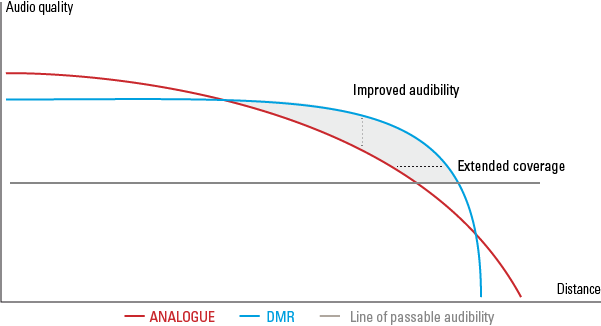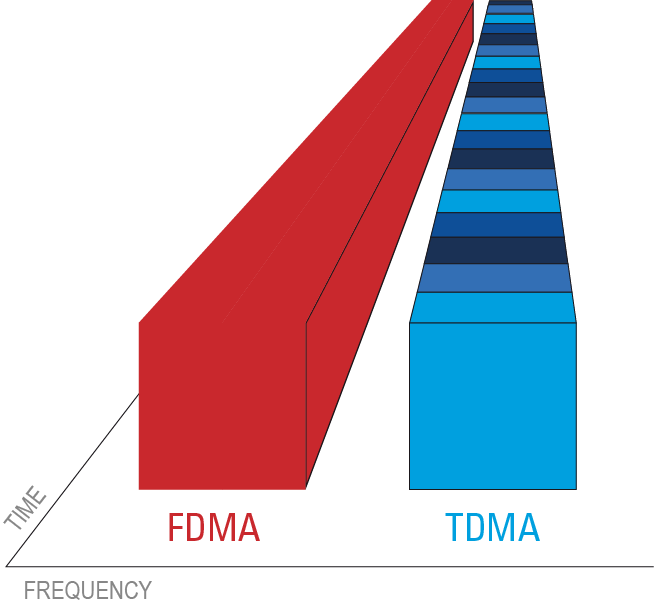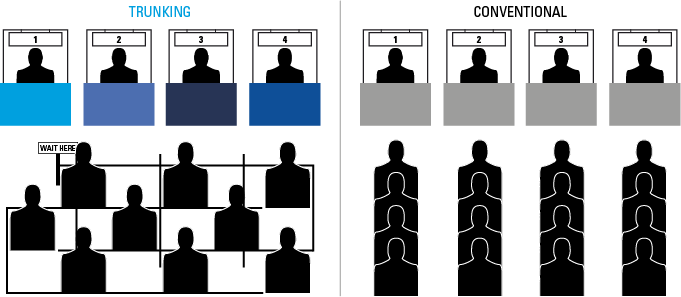An introduction to TETRA
TETRA, or TErrestrial Trunked RAdio is an internationally recognized standard for trunked digital two-way radio. Today it is the foundation of many of the world’s nationwide communications systems for public safety, like RAKEL (Sweden), SINE (Denmark) and Nødnett (Norway).
The primary goal of the development of the technology was to create a European standard for trunked digital two-way radios. The objective was to enable different manufacturers to develop and produce equipment that could interact with each other within the same system as well as facilitate the integration between different types of equipment.
Key features
Better audio
Simultaneous voice and data
More than twice the capacity
Priorities
Applications
Better coverage
Encryption
Multipoint calls
Traceability
Instantaneous connection
The physics
Radio communications has besides budget another restriction, the laws of physics. A part of the problem lies in the properties of radio waves. Simplified, low frequencies gives further reach but limited transfer rates while high frequencies have the opposite correlation between coverage and speed.

TETRA is developed primarily for organisations in need of mission-critical communications. The primary focus has therefore been to enable efficient and reliable voice transmissions with high quality audio, resulting in the use of the UHF spectrum.
In the 380-430MHz spectrum (UHF) that was chosen for TETRA some properties are obtained “automatically”. The idea was that the transfer rates should be sufficient to allow data traffic while providing a reach that does not require (too) extensive infrastructure. A TETRA system is similar to a WLAN with great coverage but reduced speed. Although, modern technology have enabled certain parameters to be adjusted to give a satisfactory result. This has resulted in the three basic techniques used to give the technology its many advantages, digitalisation, TDMA and trunking.
Digitalisation
Today almost all electronics use digital technology and wireless communications is no exception. The analogue to digital conversion that occurs when talking on a TETRA-terminal can be compared to a fax machine converting written text to data.
A so-called vocoder (voice coder / decoder) in the terminal filters the recorded sounds to eliminate ambient noise. The remaining audio (human speech) is then compressed to a digital bit stream and encoded before transmission, to minimize errors during the transmission.
After the conversion has been performed the information is organised in digital packages through a procedure called framing. Like an envelope the package includes information about the recipient and the sender. Upon transmission 60ms of speech has been compressed to 14,2ms (1/4) only to be decompressed back to 60ms on the receiver side.
Sound is recorded
The recording is converted to a data stream
The "audio" is filtered focusing on speech and is then compressed
Enables receiving radio to correct minor bit errors
Organises the data in digital packages
The package is sent
In practice the voice is converted to binary code, i.e. data. Thus the system makes no exception between the two, voice and data is completely integrated in TETRA. This enables services like text messaging and positioning and allows for images to be sent via the system.
Thanks to the digitalisation the data can also be encrypted without altering the way it is sent. Contrary to conventional two-way radio technologies that usually distorts the radio waves to prevent interception, a technique known as scrambling. With a digital encryption the packages are instead “coded” with an algorithm and transmitted as usual. But the receiving radio needs to decrypt the packages in order for the user to hear or read its contents.
With conventional two-way radio technologies noise and interference increases gradually with the distance from the source. This ultimately leads to the user not being able to distinguish what is being said despite that the signal is getting through. In a digital system on the other hand, the audio is sent as packages and the audibility is therefore not affected in the same way. For digital calls it is more of either it works well or not at all.

The steeper curve for the digital signal is explained simply by, either the package is delivered intact or it is not delivered at all.
TDMA - Time Division Multiple Access
Similar to a lot of conventional technologies TETRA uses a 25 kHz channel spacing but, in TETRA the channels are divided into timeslots. Thanks to the split in time channels are utilized much more efficiently and enables up to four independent calls to take place simultaneously on a single 25 kHz channel. The increased amount of available “communication paths” boosts system capacity, in terms of the number of users it can manage.

By assigning specific timeslots for different types of transfers, voice and data transmissions can occur simultaneously. Thanks to TDMA you can also use the system to make phone calls, i.e. duplex communications. This is achieved by using every other timeslot for transmitting and receiving.
Trunking
Trunking is a concept used to let several individuals efficiently share the same resource. With this definition trunking can be applied on just about anything, even if it is mostly used within telecom and radio communications.
Within TETRA trunking is achieved by normally keeping all user in a control channel. When a user initiates a transmission, the call will automatically be assigned a vacant timeslot on one of the carriers (discreet channels) in the system. When someone answers the conversation will continue in the assigned timeslot. But, if the answer takes more than a predefined number of seconds all users will revert back to the control channel. When the conversation is resumed the system will manage it as a completely new call and will be assigned a new timeslot. This method increases chances that there is at least one free communication path available at all times. This automatic and dynamic allocation of calls also improves integrity by preventing eavesdropping.

Trunking requires that the terminal, talk groups and individuals are registered in the system. By appointing different priorities to individuals and call types it becomes possible, in certain cases, to jump the cue if all timeslots are occupied. Thanks to this emergency calls and other traffic of similar importance can take precedent, regardless of current load. The registration also gives traceability which reduces system abuse.